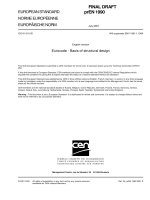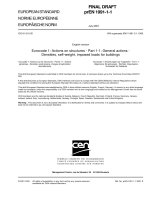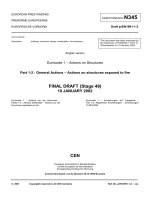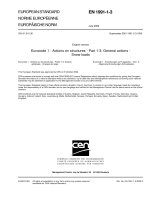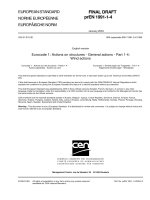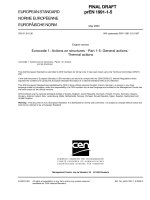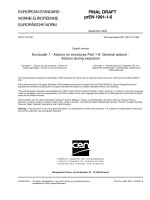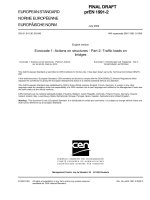Design of masonry structures Eurocode 1 Part 1,4 - prEN 1991-1-4-2004
Bạn đang xem bản rút gọn của tài liệu. Xem và tải ngay bản đầy đủ của tài liệu tại đây (2.64 MB, 148 trang )
EUROPEAN STANDARD
NORME EUROPÉENNE
FINAL DRAFT
prEN 1991-1-4
EUROPÄISCHE NORM
January 2004
ICS 91.010.30
Will supersede ENV 1991-2-4:1995
English version
Eurocode 1: Actions on structures - General actions - Part 1-4:
Wind actions
Eurocode 1 - Actions sur les structures - Partie 1-4 :
Actions générales - Actions du vent
Eurocode 1: Einwirkungen auf Tragwerke - Teil 1-4:
Allgemeine Einwirkungen - Windlasten
This draft European Standard is submitted to CEN members for formal vote. It has been drawn up by the Technical Committee CEN/TC
250.
If this draft becomes a European Standard, CEN members are bound to comply with the CEN/CENELEC Internal Regulations which
stipulate the conditions for giving this European Standard the status of a national standard without any alteration.
This draft European Standard was established by CEN in three official versions (English, French, German). A version in any other
language made by translation under the responsibility of a CEN member into its own language and notified to the Management Centre has
the same status as the official versions.
CEN members are the national standards bodies of Austria, Belgium, Cyprus, Czech Republic, Denmark, Estonia, Finland, France,
Germany, Greece, Hungary, Iceland, Ireland, Italy, Latvia, Lithuania, Luxembourg, Malta, Netherlands, Norway, Poland, Portugal, Slovakia,
Slovenia, Spain, Sweden, Switzerland and United Kingdom.
Warning : This document is not a European Standard. It is distributed for review and comments. It is subject to change without notice and
shall not be referred to as a European Standard.
EUROPEAN COMMITTEE FOR STANDARDIZATION
COMITÉ EUROPÉEN DE NORMALISATION
EUROPÄISCHES KOMITEE FÜR NORMUNG
Management Centre: rue de Stassart, 36
© 2004 CEN
All rights of exploitation in any form and by any means reserved
worldwide for CEN national Members.
B-1050 Brussels
Ref. No. prEN 1991-1-4:2004: E
Page 2
prEN 1991-1-4:2004
Contents
Page
Foreword......................................................................................................................................................................5
Section 1 General ....................................................................................................................................................9
1.1
Scope ..............................................................................................................................................................9
1.2
Normative references ..................................................................................................................................10
1.3
Assumptions ................................................................................................................................................10
1.4
Distinction between Principles and Application Rules............................................................................10
1.5
Design assisted by testing and measurements .......................................................................................10
1.6
Definitions ....................................................................................................................................................10
1.7
Symbols ........................................................................................................................................................11
Section 2
Design situations .................................................................................................................................16
Section 3 Modelling of wind actions ...................................................................................................................16
3.1
Nature............................................................................................................................................................16
3.2
Representations of wind actions ...............................................................................................................16
3.3
Classification of wind actions ....................................................................................................................16
3.4
Characteristic values...................................................................................................................................16
3.5
Models...........................................................................................................................................................17
Section 4 Wind velocity and velocity pressure ..................................................................................................18
4.1
Basis for calculation....................................................................................................................................18
4.2
Basic values .................................................................................................................................................18
4.3
Mean wind.....................................................................................................................................................19
4.3.1 Variation with height....................................................................................................................................19
4.3.2 Terrain roughness .......................................................................................................................................19
4.3.3 Terrain orography ........................................................................................................................................21
4.3.4 Large and considerably higher neighbouring structures........................................................................21
4.3.5 Closely spaced buildings and obstacles...................................................................................................22
4.4
Wind turbulence...........................................................................................................................................22
4.5
Peak velocity pressure ................................................................................................................................22
Section 5 Wind actions .........................................................................................................................................24
5.1
General..........................................................................................................................................................24
5.2
Wind pressure on surfaces.........................................................................................................................24
5.3
Wind forces ..................................................................................................................................................25
Section 6 Structural factor cscd ...........................................................................................................................28
6.1
General..........................................................................................................................................................28
6.2
Determination of cscd ..................................................................................................................................28
6.3
Detailed procedure ......................................................................................................................................28
6.3.1 Structural factor cscd ...................................................................................................................................28
6.3.2 Serviceability assessments ........................................................................................................................30
6.3.3 Wake buffeting .............................................................................................................................................30
Section 7 Pressure and force coefficients..........................................................................................................31
7.1
General..........................................................................................................................................................31
7.1.1 Choice of aerodynamic coefficient ............................................................................................................31
7.1.2 Asymmetric and counteracting pressures and forces ............................................................................32
7.1.3 Effects of ice and snow ...............................................................................................................................32
7.2
Pressure coefficients for buildings............................................................................................................33
7.2.1 General..........................................................................................................................................................33
7.2.2 Vertical walls of rectangular plan buildings..............................................................................................34
7.2.3 Flat roofs.......................................................................................................................................................37
7.2.4 Monopitch roofs...........................................................................................................................................40
7.2.5 Duopitch roofs .............................................................................................................................................43
7.2.6 Hipped roofs .................................................................................................................................................47
7.2.7 Multispan roofs ............................................................................................................................................48
Page 3
prEN 1991-1-4:2004
7.2.8
7.2.9
7.2.10
7.3
7.4
7.4.1
7.4.2
7.4.3
7.5
7.6
7.7
7.8
7.9
7.9.1
7.9.2
7.9.3
7.10
7.11
7.12
7.13
Vaulted roofs and domes............................................................................................................................50
Internal pressure..........................................................................................................................................51
Pressure on walls or roofs with more than one skin ...............................................................................54
Canopy roofs................................................................................................................................................55
Free-standing walls, parapets, fences and signboards...........................................................................62
Free-standing walls and parapets..............................................................................................................62
Shelter factors for walls, fences and parapets .........................................................................................64
Signboards ...................................................................................................................................................64
Friction coefficients.....................................................................................................................................65
Structural elements with rectangular sections.........................................................................................67
Structural elements with sharp edged section.........................................................................................68
Structural elements with regular polygonal section ................................................................................69
Circular cylinders ........................................................................................................................................71
External pressure coefficients ...................................................................................................................71
Force coefficients ........................................................................................................................................74
Force coefficients for vertical cylinders in a row arrangement ..............................................................76
Spheres.........................................................................................................................................................77
Lattice structures and scaffoldings...........................................................................................................78
Flags..............................................................................................................................................................81
Effective slenderness λ and end-effect factor ψ.......................................................................................83
Section 8 Wind actions on bridges .....................................................................................................................85
8.1
General..........................................................................................................................................................85
8.2
Choice of the response calculation procedure ........................................................................................88
8.3
Force coefficients ........................................................................................................................................88
8.3.1 Force coefficients in x-direction (general method) ..................................................................................88
8.3.2 Force in x-direction – Simplified Method ..................................................................................................91
8.3.3 Wind forces on bridge decks in z-direction ..............................................................................................91
8.3.4 Wind forces on bridge decks in y-direction..............................................................................................93
8.4
Bridge piers ..................................................................................................................................................93
8.4.1 Wind directions and design situations......................................................................................................93
8.4.2 Wind effects on piers ..................................................................................................................................93
Annex
A.1
A.2
A.3
A.4
A.5
A (informative) Terrain effects....................................................................................................................94
Illustrations of the upper roughness of each terrain category ...............................................................94
Transition between roughness categories 0, I, II, III and IV ....................................................................95
Numerical calculation of orography coefficients .....................................................................................97
Neighbouring structures...........................................................................................................................102
Displacement height..................................................................................................................................103
Annex B (informative) Procedure 1 for determining the structural factor cscd ..............................................104
B.1
Wind turbulence.........................................................................................................................................104
B.2
Structural factor cscd ................................................................................................................................105
B.3
Number of loads for dynamic response ..................................................................................................107
B.4
Service displacement and accelerations for serviceability assessments...........................................108
Annex C (informative) Procedure 2 for determining the structural factor cscd ..............................................110
C.1
Wind turbulence.........................................................................................................................................110
C.2
Structural factor .........................................................................................................................................110
C.3
Number of loads for dynamic response ..................................................................................................111
C.4
Service displacement and accelerations for serviceability assessments...........................................111
Annex D (informative) cscd values for different types of structures ...............................................................113
Annex E (informative) Vortex shedding and aeroelastic instabilities ..............................................................116
E.1
Vortex shedding.........................................................................................................................................116
E.1.1 General........................................................................................................................................................116
E.1.2 Criteria for vortex shedding......................................................................................................................116
E.1.3 Basic parameters for the classification of vortex shedding .................................................................117
E.1.4 Vortex shedding action .............................................................................................................................120
E.1.5 Calculation of the cross wind amplitude.................................................................................................120
E.1.6 Measures against vortex induced vibrations..........................................................................................130
E.2
Galloping ....................................................................................................................................................131
E.2.1 General........................................................................................................................................................131
E.2.2 Onset wind velocity ...................................................................................................................................131
Page 4
prEN 1991-1-4:2004
E.2.3
E.3
E.4
E.4.1
E.4.2
E.4.3
Classical galloping of coupled cylinders ................................................................................................133
Interference galloping of two or more free standing cylinders.............................................................135
Divergence and Flutter ..............................................................................................................................136
General........................................................................................................................................................136
Criteria for plate-like structures ...............................................................................................................136
Divergency velocity ...................................................................................................................................136
Annex F (informative) Dynamic characteristics of structures ..........................................................................138
F.1
General........................................................................................................................................................138
F.2
Fundamental frequency ............................................................................................................................138
F.3
Fundamental mode shape.........................................................................................................................143
F.4
Equivalent mass.........................................................................................................................................145
F.5
Logarithmic decrement of damping.........................................................................................................145
Page 5
prEN 1991-1-4:2004
Foreword
This European Standard has been prepared by Technical Committee CEN/TC250 "Structural Eurocodes", the
Secretariat for which is held by BSI.
This document is currently submitted to the formal vote.
This European Standard supersedes ENV 1991-2-4: 1995.
The Annexes A, B, C, D, E and F are informative.
Background of the Eurocode programme
In 1975, the Commission of the European Community decided on an action programme in the field of construction,
based on article 95 of the Treaty. The objective of the programme was the elimination of technical obstacles to
trade and the harmonisation of technical specifications.
Within this action programme, the Commission took the initiative to establish a set of harmonised technical rules for
the design of construction works which, in a first stage, would serve as an alternative to the national rules in force in
the Member States and, ultimately, would replace them.
For fifteen years, the Commission, with the help of a Steering Committee with Representatives of Member States,
conducted the development of the Eurocodes programme, which led to the first generation of European codes in
the 1980s.
In 1989, the Commission and the Member States of the EU and EFTA decided, on the basis of an agreement1
between the Commission and CEN, to transfer the preparation and the publication of the Eurocodes to the CEN
through a series of Mandates, in order to provide them with a future status of European Standard (EN). This links
de facto the Eurocodes with the provisions of all the Council’s Directives and/or Commission’s Decisions dealing
with European standards (e.g. the Council Directive 89/106/EEC on construction products - CPD - and Council
Directives 93/37/EEC, 92/50/EEC and 89/440/EEC on public works and services and equivalent EFTA Directives
initiated in pursuit of setting up the internal market).
1 Agreement between the Commission of the European Communities and the European Committee for Standardisation (CEN) concerning the
work on EUROCODES for the design of building and civil engineering works (BC/CEN/03/89).
Page 6
prEN 1991-1-4:2004
The Structural Eurocode programme comprises the following standards generally consisting of a number of Parts :
EN 1990
Eurocode :
Basis of Structural Design
EN 1991
Eurocode 1:
Actions on structures
EN 1992
Eurocode 2:
Design of concrete structures
EN 1993
Eurocode 3:
Design of steel structures
EN 1994
Eurocode 4:
Design of composite steel and concrete structures
EN 1995
Eurocode 5:
Design of timber structures
EN 1996
Eurocode 6:
Design of masonry structures
EN 1997
Eurocode 7:
Geotechnical design
EN 1998
Eurocode 8:
Design of structures for earthquake resistance
EN 1999
Eurocode 9:
Design of aluminium structures
Eurocode standards recognise the responsibility of regulatory authorities in each Member State and have
safeguarded their right to determine values related to regulatory safety matters at national level where these
continue to vary from State to State.
Status and field of application of Eurocodes
The Member States of the EU and EFTA recognise that Eurocodes serve as reference documents for the following
purposes :
–
as a means to prove compliance of building and civil engineering works with the essential requirements of
Council Directive 89/106/EEC, particularly Essential Requirement N°1 – Mechanical resistance and stability –
and Essential Requirement N°2 –Safety in case of fire ;
–
as a basis for specifying contracts for construction works and related engineering services ;
–
as a framework for drawing up harmonised technical specifications for construction products (ENs and ETAs)
The Eurocodes, as far as they concern the construction works themselves, have a direct relationship with the
Interpretative Documents2 referred to in Article 12 of the CPD, although they are of a different nature from
harmonised product standards3. Therefore, technical aspects arising from the Eurocodes work need to be
adequately considered by CEN Technical Committees and/or EOTA Working Groups working on product standards
with a view to achieving full compatibility of these technical specifications with the Eurocodes.
The Eurocode standards provide common structural design rules for everyday use for the design of whole
structures and component products of both a traditional and an innovative nature. Unusual forms of construction or
2 According to Art. 3.3 of the CPD, the essential requirements (ERs) shall be given concrete form in interpretative documents for the creation of
the necessary links between the essential requirements and the mandates for harmonised ENs and ETAGs/ETAs.
3 According to Art. 12 of the CPD the interpretative documents shall :
a)
give concrete form to the essential requirements by harmonising the terminology and the technical bases and indicating classes or levels for each
requirement where necessary ;
b)
indicate methods of correlating these classes or levels of requirement with the technical specifications, e.g. methods of calculation and of proof
technical rules for project design, etc. ;
c)
serve as a reference for the establishment of harmonised standards and guidelines for European technical approvals.
The Eurocodes, de facto, play a similar role in the field of the ER 1 and a part of ER 2.
Page 7
prEN 1991-1-4:2004
design conditions are not specifically covered and additional expert consideration will be required by the designer
in such cases.
National Standards implementing Eurocodes
The National Standards implementing Eurocodes will comprise the full text of the Eurocode (including any
annexes), as published by CEN, which may be preceded by a National title page and National foreword, and may
be followed by a National annex.
The National annex may only contain information on those parameters which are left open in the Eurocode for
national choice, known as Nationally Determined Parameters, to be used for the design of buildings and civil
engineering works to be constructed in the country concerned, i.e. :
–
values and/or classes where alternatives are given in the Eurocode,
–
values to be used where a symbol only is given in the Eurocode,
–
country specific data (geographical, climatic, etc.), e.g. wind map,
–
the procedure to be used where alternative procedures are given in the Eurocode.
It may also contain
–
decisions on the use of informative annexes, and
–
references to non-contradictory complementary information to assist the user to apply the Eurocode.
Links between Eurocodes and harmonised technical specifications (ENs and ETAs) for products
There is a need for consistency between the harmonised technical specifications for construction products and the
technical rules for works4. Furthermore, all the information accompanying the CE Marking of the construction
products which refer to Eurocodes should clearly mention which Nationally Determined Parameters have been
taken into account.
Additional information specific for EN 1991-1-4
EN 1991-1-4 gives design guidance and actions for the structural design of buildings and civil engineering works for
wind.
EN 1991-1-4 is intended for the use by clients, designers, contractors and relevant authorities.
EN 1991-1-4 is intended to be used with EN 1990, the other Parts of EN 1991 and EN 1992-1999 for the design of
structures.
National annex for EN 1991-1- 4
This standard gives alternative procedures, values and recommendations for classes with notes indicating where
National choice may be made. Therefore the National Standard implementing EN 1991-1-4 should have a National
Annex containing Nationally Determined Parameters to be used for the design of buildings and civil engineering
works to be constructed in the relevant country.
National choice is allowed for EN 1991-1-4 through clauses:
1.1 (12)
4 see Art.3.3 and Art.12 of the CPD, as well as clauses 4.2, 4.3.1, 4.3.2 and 5.2 of ID 1.
Page 8
prEN 1991-1-4:2004
4.1 (1)
4.2 (1)P Note 2
4.2 (2)P Notes 1, 2, 3 and 5
4.3.1 (1) Notes 1 and 2
4.3.2 (1)
4.3.2 (2)
4.3.3 (1)
4.3.4 (1)
4.3.5 (1)
4.4 (1) Note 2
4.5 (1) Notes 1 and 2
5.3 (5)
6.1 (1)
6.3.1 (1) Note 3
6.3.2 (1)
7.1.2 (2)
7.1.3 (1)
7.2.1 (1) Note 2
7.2.2 (1)
7.2.2 (2) Note 1
7.2.8 (1)
7.2.9 (2)
7.2.10 (3) Notes 1 and 2
7.4.1 (1)
7.6 (1) Note 1
7.7 (1) Note 1
7.8 (1)
7.10 (1) Note 1
7.11 (1) Note 2
7.13 (1)
7.13 (2)
8.1 (1) Notes 1 and 2
8.1 (4)
8.1 (5)
8.2 (1) Note 1
8.3 (1)
8.3.1 (2)
8.3.2 (1)
8.3.3 (1) Note 1
8.3.4 (1)
8.4.2 (1) Notes 1 and 2
A.2 (1)
E.1.3.3 (1)
E.1.5.1 (1) Notes 1 and 2
E.1.5.1 (3)
E.1.5.2.6 (1) Note 1
E.1.5.3 (2) Note 1
E.1.5.3 (4)
E.1.5.3 (6)
E.3 (2)
Page 9
prEN 1991-1-4:2004
1
General
1.1 Scope
(1) EN 1991-1-4 gives guidance on the determination of natural wind actions for the structural design
of building and civil engineering works for each of the loaded areas under consideration. This includes
the whole structure or parts of the structure or elements attached to the structure, e. g. components,
cladding units and their fixings, safety and noise barriers.
(2) This Part is applicable to:
–
Buildings and civil engineering works with heights up to 200 m. See also (11) and (12).
–
Bridges having no span greater than 200 m, provided that they satisfy the criteria for dynamic
response, see (12) and 8.2.
(3) This part is intended to predict characteristic wind actions on land-based structures, their
components and appendages.
(4) Certain aspects necessary to determine wind actions on a structure are dependent on the location
and on the availability and quality of meteorological data, the type of terrain, etc. These need to be
provided in the National Annex and Annex A, through National choice by notes in the text as indicated.
Default values and methods are given in the main text, where the National Annex does not provide
information.
(5) Annex A gives illustrations of the terrain categories and provides rules for the effects of orography
including displacement height, roughness change, influence of landscape and influence of
neighbouring structures.
(6) Annex B and C give alternative procedures for calculating the structural factor cscd.
(7) Annex D gives cscd factors for different types of structures.
(8) Annex E gives rules for vortex induced response and some guidance on other aeroelastic effects.
(9) Annex F gives dynamic characteristics of structures with linear behaviour
(10) This part does not give guidance on local thermal effects on the characteristic wind, e.g. strong
arctic thermal surface inversion or funnelling or tornadoes.
(11) Guyed masts and lattice towers are treated in EN 1993-7-1 and lighting columns in EN 40
(12) This part does not give guidance on the following aspects:
–
torsional vibrations, e.g. tall buildings with a central core
–
bridge deck vibrations from transverse wind turbulence
–
cable supported bridges
–
vibrations where more than the fundamental mode needs to be considered
NOTE The National Annex may provide guidance on these aspects as non contradictory complementary
information.
Page 10
prEN 1991-1-4:2004
1.2 Normative references
The following normative documents contain provisions which, through references in this text,
constitute provisions of this European standard. For dated references, subsequent amendments to, or
revisions of any of these publications do not apply. However, parties to agreements based on this
European standard are encouraged to investigate the possibility of applying the most recent editions
of the normative documents indicated below. For undated references the latest edition of the
normative document referred to applies.
EN 1990
Eurocode:
Basis of structural design
EN 1991-1-3 Eurocode 1: Actions on structures: Part 1-3: Snow loads
EN 1991-1-6 Eurocode 1: Actions on structures: Part 1-6: Actions during execution
EN 1991-2
Eurocode 1: Actions on structures: Part 2:
Traffic loads on bridges
1.3 Assumptions
(1)P The general assumptions given in EN 1990, 1.3 apply.
1.4 Distinction between Principles and Application Rules
(1)P The rules in EN 1990, 1.4 apply.
1.5 Design assisted by testing and measurements
(1) With the approval of the appropriate Authority, wind tunnel tests and proven and/or properly
validated numerical methods may be used to obtain load and response information, using appropriate
models of the structure and of the natural wind.
(2) With the approval of the appropriate Authority, load and response information and terrain
parameters may be obtained by appropriate full scale data.
1.6 Definitions
For the purposes of this European Standard, the definitions given in ISO 2394, ISO 3898 and ISO
8930 and the following apply. Additionally for the purposes of this Standard a basic list of definitions is
provided in EN 1990,1.5.
1.6.1
fundamental basic wind velocity
the 10 minute mean wind velocity with an annual risk of being exceeded of 0, 02, irrespective of wind
direction, at a height of 10 m above flat open country terrain and accounting for altitude effects (if
required)
1.6.2
basic wind velocity
the fundamental basic wind velocity modified to account for the direction of the wind being considered
and the season (if required)
1.6.3
mean wind velocity
the basic wind velocity modified to account for the effect of terrain roughness and orography
Page 11
prEN 1991-1-4:2004
1.6.4
pressure coefficient
external pressure coefficients give the effect of the wind on the external surfaces of buildings; internal
pressure coefficients give the effect of the wind on the internal surfaces of buildings.
The external pressure coefficients are divided into overall coefficients and local coefficients. Local
2
coefficients give the pressure coefficients for loaded areas of 1 m or less e.g. for the design of small
elements and fixings; overall coefficients give the pressure coefficients for loaded areas larger than
2
10 m .
Net pressure coefficients give the resulting effect of the wind on a structure, structural element or
component per unit area.
1.6.5
force coefficient
force coefficients give the overall effect of the wind on a structure, structural element or component as
a whole, including friction, if not specifically excluded
1.6.6
background response factor
the background factor allowing for the lack of full correlation of the pressure on the structure surface
1.6.7
resonance response factor
the resonance response factor allowing for turbulence in resonance with the vibration mode
1.7 Symbols
(1) For the purposes of this European standard, the following symbols apply
NOTE The notation used is based on ISO 3898:1999. In this Part the symbol dot in expressions indicates
the multiplication sign. This notation has been employed to avoid confusion with functional expressions.
(2) A basic list of notations is provided in EN 1990, 1.6 and the additional notations below are specific
to EN 1991-1-4.
Latin upper case letters
A
area
Afr
area swept by the wind
Aref
reference area
B2
background response part
C
wind load factor for bridges
E
Young’s modulus
Ffr
resultant friction force
Fj
vortex exciting force at point j of the structure
Fw
resultant wind force
H
height of a topographic feature
Iv
turbulence intensity
K
mode shape factor; shape parameter
Kiv
interference factor for vortex shedding
Krd
reduction factor for parapets
Kw
correlation length factor
Page 12
prEN 1991-1-4:2004
Kx
non dimensional coefficient
L
length of the span of a bridge deck; turbulent length scale
Ld
actual length of a downwind slope
Le
effective length of an upwind slope
Lj
correlation length
Lu
actual length of an upwind slope
N
number of cycles caused by vortex shedding
Ng
R
2
number of loads for gust response
resonant response part
Re
Reynolds number
Rh, Rb
aerodynamic admittance
S
wind action
Sc
Scruton number
SL
non dimensional power spectral density function
St
Strouhal number
Ws
weight of the structural parts contributing to the stiffness of a chimney
Wt
total weight of a chimney
Latin lower case letters
aG
factor of galloping instability
aIG
combined stability parameter for interference galloping
b
width of the structure
calt
altitude factor
cd
dynamic factor
cdir
directional factor
cf
force coefficient
cf,o
force coefficient of structures or structural elements without free-end flow
cf,l
lift force coefficient
cfr
friction coefficient
clat
aerodynamic exciting coefficient
cM
moment coefficient
cp
pressure coefficient
cprob
probability factor
cr
roughness factor
co
orography factor
cs
size factor
cseason
seasonal factor
d
depth of the structure
Page 13
prEN 1991-1-4:2004
e
eccentricity of a force or edge distance
fL
non dimensional frequency
h
height of the structure
hdis
displacement height
k
equivalent roughness
kp
peak factor
kr
terrain factor
kΘ
torsional stiffness
l
length of a horizontal structure
m
mass per unit length
m1
equivalent mass per unit length
ni
natural frequency of the structure of the mode i
n1,x
fundamental frequency of along wind vibration
n1,y
fundamental frequency of cross-wind vibration
n0
ovalling frequency
p
annual probability of exceedence
qb
reference mean (basic) velocity pressure
qp
peak velocity pressure
r
radius
s
factor; coordinate
t
averaging time of the reference wind speed, plate thickness
vCG
onset wind velocity for galloping
vCIG
critical wind velocity for interference galloping
vcrit
critical wind velocity of vortex shedding
vdiv
divergence wind velocity
vm
mean wind velocity
vb,0
fundamental value of the basic wind velocity
vb
basic wind velocity
w
wind pressure
x
horizontal distance of the site from the top of a crest
x-direction
horizontal direction, perpendicular to the span
y-direction
horizontal direction along the span
ymax
maximum cross-wind amplitude at critical wind speed
z
height above ground
zave
average height
z-direction
vertical direction
z0
roughness length
ze, zi
reference height for external wind action, internal pressure
zg
distance from the ground to the considered component
zmax
maximum height
Page 14
prEN 1991-1-4:2004
zmin
minimum height
Greek upper case letters
Φ
upwind slope
Φ1,x
fundamental alongwind modal shape
θ
torsional angle
Greek lower case letters
αG
galloping instability parameter
αIG
combined stability parameter of interference galloping
δ
logarithmic decrement of damping
δa
aerodynamic logarithmic decrement of damping
δd
logarithmic decrement of damping due to special devices
δs
structural logarithmic decrement of damping
ε
coefficient
ε0
bandwidth factor
ε1
frequency factor
η
variable
ϕ
solidity ratio, blockage of canopy
λ
slenderness ratio
µ
opening ratio, permeability of a skin
ν
up-crossing frequency, Poisson ratio, kinematic viscosity
ρ
air density
σv
standard deviation of the turbulence
σa,x
standard deviation of alongwind acceleration
ψmc
reduction factor for multibay canopies
ψr
reduction factor of force coefficient for square sections with rounded corners
ψλ
reduction factor of force coefficient for structural elements with end-effects
ψλα
end-effect factor for circular cylinders
ψs
shelter factor for walls and fences
ψsc
reduction factor of force coefficient for scaffoldings effected by solid building face
ζ
exponent of mode shape
Indices
crit
critical
e
external, exposure
Page 15
prEN 1991-1-4:2004
fr
friction
i
internal, mode number
j
current number of incremental area or point of a structure
m
mean
p
peak, parapet
ref
reference
v
wind velocity
x
alongwind direction
y
cross-wind direction
z
vertical direction
Page 16
prEN 1991-1-4:2004
2
Design situations
(1)P The relevant wind actions shall be determined for each design situation identified in accordance with EN 1990,
3.2.
(2) In accordance with EN 1990, 3.2 (3)P other actions (such as snow, traffic or ice) which will modify the effects
due to wind should be taken into account.
NOTE See also EN 1991-1-3, EN 1991-2 and ISO FDIS12494
(3) In accordance with EN 1990, 3.2 (3)P, the changes to the structure during stages of execution (such as different
stages of the form of the structure, dynamic characteristics, etc.), which may modify the effects due to wind, should
be taken into account.
NOTE See also EN 1991-1-6
(4) Where in design windows and doors are assumed to be shut under storm conditions, the effect of these being
open should be treated as an accidental design situation.
NOTE See also EN 1990, 3.2 (2) (P)
(5) Fatigue due to the effects of wind actions should be considered for susceptible structures.
NOTE The number of load cycles may be obtained from Annex B, C and E.
3
Modelling of wind actions
3.1 Nature
(1) Wind actions fluctuate with time and act directly as pressures on the external surfaces of enclosed structures
and, because of porosity of the external surface, also act indirectly on the internal surfaces. They may also act
directly on the internal surface of open structures. Pressures act on areas of the surface resulting in forces normal
to the surface of the structure or of individual cladding components. Additionally, when large areas of structures are
swept by the wind, friction forces acting tangentially to the surface may be significant.
3.2 Representations of wind actions
(1) The wind action is represented by a simplified set of pressures or forces whose effects are equivalent to the
extreme effects of the turbulent wind.
3.3 Classification of wind actions
(1) Unless otherwise specified, wind actions should be classified as variable fixed actions, see EN 1990, 4.1.1.
3.4 Characteristic values
(1) The wind actions calculated using EN 1991-1-4 are characteristic values (See EN 1990, 4.1.2). They are
determined from the basic values of wind velocity or the velocity pressure. In accordance with EN 1990 4.1.2 (7)P
the basic values are characteristic values having annual probabilities of exceedence of 0,02, which is equivalent to
a mean return period of 50 years.
NOTE All coefficients or models, to derive wind actions from basic values, are chosen so that the probability of the
calculated wind actions does not exceed the probability of these basic values.
Page 17
prEN 1991-1-4:2004
3.5 Models
(1) The effect of the wind on the structure (i.e. the response of the structure), depends on the size, shape and
dynamic properties of the structure. This Part covers dynamic response due to along-wind turbulence in resonance
with the along-wind vibrations of a fundamental flexural mode shape with constant sign.
The response of structures should be calculated according to Section 5 from the peak velocity pressure, qp, at the
reference height in the undisturbed wind field, the force and pressure coefficients and the structural factor cscd (see
Section 6). qp depends on the wind climate, the terrain roughness and orography, and the reference height. qp is
equal to the mean velocity pressure plus a contribution from short-term pressure fluctuations.
(2) Aeroelastic response should be considered for flexible structures such as cables, masts, chimneys and
bridges.
NOTE Simplified guidance on aeroelastic response is given in Annex E.
Page 18
prEN 1991-1-4:2004
4
Wind velocity and velocity pressure
4.1 Basis for calculation
(1) The wind velocity and the velocity pressure are composed of a mean and a fluctuating component.
The mean wind velocity vm should be determined from the basic wind velocity vb which depends on the wind
climate as described in 4.2, and the height variation of the wind determined from the terrain roughness and
orography as described in 4.3. The peak velocity pressure is determined in 4.5.
The fluctuating component of the wind is represented by the turbulence intensity defined in 4.4.
NOTE The National Annex may provide National climatic information from which the mean wind velocity vm, the peak
velocity pressure qp and additional values may be directly obtained for the terrain categories considered.
4.2 Basic values
(1)P The fundamental value of the basic wind velocity, vb,0, is the characteristic 10 minutes mean wind velocity,
irrespective of wind direction and time of year, at 10 m above ground level in open country terrain with low
vegetation such as grass and isolated obstacles with separations of at least 20 obstacle heights.
NOTE 1
This terrain corresponds to terrain category II in Table 4.1.
NOTE 2
The value of the basic wind velocity, vb,0, may be given in the National Annex.
(2)P The basic wind velocity shall be calculated from Expression (4.1).
v b = c dir ⋅ c season ⋅ v b,0
(4.1)
where:
vb
is the basic wind velocity, defined as a function of wind direction and time of year at 10 m above ground of
terrain category II
vb,0
is the fundamental value of the basic wind velocity, see (1)P
cdir
is the directional factor, see Note 2.
cseason is the season factor, see Note 3.
NOTE 1
Where the influence of altitude on the basic wind velocity vb is not included in the specified fundamental
value vb,0 the National Annex may give a procedure to take it into account.
NOTE 2
The value of the directional factor, cdir, for various wind directions may be found in the National Annex. The
recommended value is 1,0.
NOTE 3
The value of the season factor, cseason, may be given in the National Annex. The recommended value is 1,0.
NOTE 4
The 10 minutes mean wind velocity having the probability p for an annual exceedence is determined by
multiplying the basic wind velocity vb in 4.2 (2)P by the probability factor, cprob given by Expression (4.2). See also EN
1991-1-6.
Page 19
prEN 1991-1-4:2004
cprob
1 − K ⋅ ln( − ln(1 − p ))
=
1 − K ⋅ ln( − ln(0,98))
n
(4.2)
where:
K
is the shape parameter depending on the coefficient of variation of the extreme-value distribution.
n
is the exponent.
NOTE 5
0,5 for n.
The values for K and n may be given in the National Annex. The recommended values are 0,2 for K and
(3) For temporary structures and for all structures in the execution phase, the seasonal factor cseason may be used.
For transportable structures, which may be used at any time in the year, cseason should be taken equal to 1,0.
NOTE See also EN 1991-1-6.
4.3 Mean wind
4.3.1
Variation with height
(1) The mean wind velocity vm(z) at a height z above the terrain depends on the terrain roughness and orography
and on the basic wind velocity, vb, and should be determined using Expression (4.3)
v m ( z ) = cr ( z ) ⋅ co ( z ) ⋅ v b
(4.3)
where:
cr(z)
is the roughness factor, given in 4.3.2
co(z)
is the orography factor, taken as 1,0 unless otherwise specified in 4.3.3
NOTE 1
Information on cO may be given in the National Annex. If the orography is accounted for in the basic wind
velocity, the recommended value is 1,0.
NOTE 2
Design charts or tables for vm(z) may be given in the National Annex.
The influence of neighbouring structures on the wind velocity should be considered (see 4.3.4).
4.3.2
Terrain roughness
(1) The roughness factor, cr(z), accounts for the variability of the mean wind velocity at the site of the structure due
to:
–
the height above ground level
–
the ground roughness of the terrain upwind of the structure in the wind direction considered
NOTE The procedure for determining cr(z) may be given in the National Annex.The recommended procedure for the
determination of the roughness factor at height z is given by Expression (4.4) and is based on a logarithmic velocity
profile.
Page 20
prEN 1991-1-4:2004
z
c ( z ) = k ⋅ ln
z
r
r
0
c (z) = c (z
)
r
r min
for
z
for
z≤z
min
≤z≤z
max
(4.4)
min
where:
z0
is the roughness length
kr
terrain factor depending on the roughness length z0 calculated using
z
k r = 0,19 ⋅ 0
z
0,II
0,07
(4.5)
where:
z0,II = 0,05 m (terrain category II, Table 4.1)
zmin is the minimum height defined in Table 4.1
zmax is to be taken as 200 m, unless otherwise specified in the National Annex
z0, zmin depend on the terrain category. Recommended values are given in Table 4.1 depending on five representative
terrain categories.
Expression (4.4) is valid when the upstream distance with uniform terrain roughness is long enough to stabilise the
profile sufficiently. See (2).
Table 4.1 — Terrain categories and terrain parameters
Terrain category
z0
zmin
m
m
0
Sea or coastal area exposed to the open sea
0,003
1
I
Lakes or flat and horizontal area with negligible vegetation and
without obstacles
0,01
1
II
Area with low vegetation such as grass and isolated obstacles
(trees, buildings) with separations of at least 20 obstacle heights
0,05
2
III
Area with regular cover of vegetation or buildings or with isolated
obstacles with separations of maximum 20 obstacle heights (such
as villages, suburban terrain, permanent forest)
0,3
5
Area in which at least 15 % of the surface is covered with buildings
and their average height exceeds 15 m
1,0
10
IV
The terrain categories are illustrated in Annex A.1.
(2) The terrain roughness to be used for a given wind direction depends on the ground roughness and the distance
with uniform terrain roughness in an angular sector around the wind direction. Small areas (less than 10% of the
area under consideration) with deviating roughness may be ignored. See Figure 4.1.
Page 21
prEN 1991-1-4:2004
NOTE The National Annex may give definitions of the angular sector and of the upstream distance. The recommended
value of the angular sector may be taken as the 30º angular sector within ±15° from the wind direction. The
recommended value for the upstream distance may be obtained from Annex A.2.
Figure 4.1 — Assessment of terrain roughness
(3) When a pressure or force coefficient is defined for a nominal angular sector, the lowest roughness length within
any 30° angular wind sector should be used.
(4) When there is choice between two or more terrain categories in the definition of a given area, then the area
with the lowest roughness length should be used.
4.3.3
Terrain orography
(1) Where orography (e.g. hills, cliffs etc.) increases wind velocities by more than 5% the effects should be taken
into account using the orography factor cO.
NOTE The procedure to be used for determining cO may be given in the National Annex. The recommended procedure
is given in Annex A.3.
(2) The effects of orography may be neglected when the average slope of the upwind terrain is less than 3°. The
upwind terrain may be considered up to a distance of 10 times the height of the isolated orographic feature.
4.3.4
Large and considerably higher neighbouring structures
(1) If the structure is to be located close to another structure, that is at least twice as high as the average height of
its neighbouring structures, then it could be exposed (dependent on the properties of the structure) to increased
wind velocities for certain wind directions. Such cases should be taken into account.
NOTE The National Annex may give a procedure to take account of this effect. .A recommended conservative first
approximation is given in Annex A.4.
Page 22
prEN 1991-1-4:2004
4.3.5
Closely spaced buildings and obstacles
(1) The effect of closely spaced buildings and other obstacles may be taken into account.
NOTE The National Annex may give a procedure. A recommended first approximation is given in Annex A.5. In rough
terrain closely spaced buildings modify the mean wind flow near the ground, as if the ground level was raised to a height
called displacement height hdis.
4.4 Wind turbulence
(1) The turbulence intensity Iv(z) at height z is defined as the standard deviation of the turbulence divided by the
mean wind velocity.
NOTE 1
The turbulent component of wind velocity has a mean value of 0 and a standard deviation σv. The standard
deviation of the turbulence σv may be determined using Expression (4.6).
σ v = kr ⋅ v b ⋅ kI
(4.6)
For the terrain factor kr see Expression (4.5), for the basic wind velocity vb see Expression (4.1) and for turbulence factor
kI see Note 2.
NOTE 2
The recommended rules for the determination of Iv(z) are given in Expression (4.7)
I v (z ) =
σv
v m (z )
=
kI
c o (z ) ⋅ ln( z / z0 )
I v (z ) = I v ( zmin )
for
zmin ≤ z ≤ zmax
for
z < zmin
(4.7)
where:
kI
is the turbulence factor. The value of kI may be given in the National Annex. The recommended value is kI = 1,0.
co
is the orography factor as described in 4.3.3
z0
is the roughness length, given in Table 4.1
4.5 Peak velocity pressure
(1) The peak velocity pressure qp(z) at height z, which includes mean and short-term velocity fluctuations, should
be determined.
NOTE 1
The National Annex may give rules for the determination of qp(z). The recommended rule is given in
Expression (4.8).
q p ( z ) = [1 + 7 ⋅ I v ( z )] ⋅
1
⋅ ρ ⋅ v m2 ( z ) = c e ( z ) ⋅ q b
2
(4.8)
where:
ρ
is the air density, which depends on the altitude, temperature and barometric pressure to be expected in the region
during wind storms
ce(z) is the exposure factor given in Expression (4.9)
c e (z) =
qb
q p (z)
qb
is the basic velocity pressure given in Expression (4.10)
(4.9)
Page 23
prEN 1991-1-4:2004
qb =
1
⋅ ρ ⋅ v b2
2
(4.10)
The value 7 in Expression (4.8) is based on a peak factor equal to 3,5 and is consistent with the values of the pressure
and force coefficients in Section 7.
For flat terrain where cO(z) = 1,0 (see 4.3.3), the exposure factor ce(z) is illustrated in Figure 4.2 as a function of height
above terrain and a function of terrain category as defined in Table 4.1.
Figure 4.2 — Illustrations of the exposure factor ce(z) for cO=1,0, kI=1,0
NOTE 2
3
The values for ρ may be given in the National Annex. The recommended value is 1,25 kg/m .
Page 24
prEN 1991-1-4:2004
5
Wind actions
5.1 General
(1)P Wind actions on structures and structural elements shall be determined taking account of both external and
internal wind pressures.
NOTE A summary of calculation procedures for the determination of wind actions is given in Table 5.1.
Table 5.1 —Calculation procedures for the determination of wind actions
Parameter
Subject Reference
peak velocity pressure qp
basic wind velocity vb
4.2 (2)P
reference height ze
Section 7
terrain category
Table 4.1
characteristic peak velocity pressure qp
4.5 (1)
turbulence intensity Iv
4.4
mean wind velocity vm
4.3.1
orography coefficient co(z)
4.3.3
roughness coefficient cr(z)
4.3.2
Wind pressures, e.g. for cladding, fixings and structural
parts
internal pressure coefficient cpi
Section 7
external pressure coefficient cpe
Section 7
external wind pressure: we=qp cpe
5.2 (1)
internal wind pressure: wi=qp cpi
5.2 (2)
Wind forces on structures, e.g. for overall wind effects
structural factor: cscd
6
wind force Fw calculated from force coefficients
5.3 (2)
wind force Fw calculated from pressure coefficients
5.3 (3)
5.2 Wind pressure on surfaces
(1) The wind pressure acting on the external surfaces, we , should be obtained from Expression (5.1).
w e = q p ( z e ) ⋅ c pe
where:
qp(ze)
is the peak velocity pressure
ze
is the reference height for the external pressure given in Section 7
cpe
is the pressure coefficient for the external pressure, see Section 7.
(5.1)
Page 25
prEN 1991-1-4:2004
NOTE qp(z) is defined in 4.5
(2) The wind pressure acting on the internal surfaces of a structure, wi , should be obtained from Expression (5.2)
w i = q p ( z i ) ⋅ c pi
(5.2)
where:
qp(zi)
is the peak velocity pressure
zi
is the reference height for the internal pressure given in Section 7
cpi
is the pressure coefficient for the internal pressure given in Section 7
NOTE qp(z) is defined in 4.5
(3) The net pressure on a wall, roof or element is the difference between the pressures on the opposite surfaces
taking due account of their signs. Pressure, directed towards the surface is taken as positive, and suction, directed
away from the surface as negative. Examples are given in Figure 5.1.
Figure 5.1 — Pressure on surfaces
5.3
Wind forces
(1) The wind forces for the whole structure or a structural component should be determined:
–
by calculating forces using force coefficients (see (2)) or
–
by calculating forces from surface pressures (see (3))
(2) The wind force Fw acting on a structure or a structural component may be determined directly by using
Expression (5.3)
Fw = c s c d ⋅ c f ⋅ q p ( z e ) ⋅ Aref
(5.3)
or by vectorial summation over the individual structural elements (as shown in 7.2.2) by using Expression (5.4)
